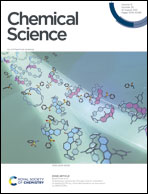Pd/Cu-Catalyzed amide-enabled selectivity-reversed borocarbonylation of unactivated alkenes†
Abstract
The addition reaction between CuBpin and alkenes to give a terminal boron substituted intermediate is usually fast and facile. In this communication, a selectivity-reversed procedure has been designed and established. This selectivity-reversed borocarbonylation reaction is enabled by a cooperative action between palladium and copper catalysts and proceeds with complete regioselectivity. The key to the success of this transformation is the coordination of the amide group and slower CuBpin formation by using KHCO3 as the base. A wide range of β-boryl ketones were produced from terminal unactivated aliphatic alkenes and aryl iodides. Further synthetic transformations of the obtained β-boryl ketones have been developed as well.



 Please wait while we load your content...
Please wait while we load your content...